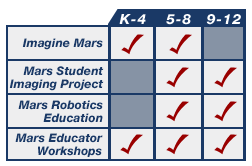Hari ini sebuah wahana bernama Curiosity berhasil mendarat di Planet Mars
Setelah terbang selama 8,5 bulan, setelah menghabiskan dana hampir Rp. 22.000.000.000.000., setelah melewati teror kegagalan pendaratan selama tujuh menit, akhirnya.
Curiosity Lands on Mars
| Operator | NASA |
|---|---|
| Major contractors | |
| Mission type | Rover |
| Launch date | November 26, 2011 15:02:00.211 UTC (10:02 EST) |
| Launch vehicle | Atlas V 541 (AV-028) |
| Launch site | Cape Canaveral LC-41 |
| Mission duration | 668 Martian sols (686 Earth days) |
| COSPAR ID | 2011-070A |
| Homepage | Mars Science Laboratory |
| Mass | 900 kg (2,000 lb) |
| Power | Radioisotope Thermoelectric Generator (RTG) |
| Mars landing | |
| Date | August 6, 2012,
05:14:39 UTC MSD 49269 15:00:01 LMST (Mars time) MSD 49269 05:50:16 AMT |
| Coordinates | Aeolis Palus in Gale Crater, 4°35′31″S 137°26′25″E |
> Full Mission Section
> Fact Sheet (PDF)
> Landing Press Kit (PDF)
> All Mars Missions
Mungkinkah manusia bisa mengunjungi Planet Mars dan membangun peradaban di sana?
Kandidat negara yang akan melakukan pendaratan tersebut adalah:
1. USA
2. China
3. Russia
4. India
Lalu di mana posisi Indonesia?
Indonesia bisa menjadi negara penyedia SDM dan IPTEK pendukung Misi besar ini.
Para ilmuwan di Indonesia membangun Masyarakat Mars Indonesia yang bertujuan untuk meneliti dan mengembangkan IPTEK eksplorasi Planet Mars.
Pembangunan Peradaban di Kawasan Planet Mars diprediksi akan dimulai pada tahun 2080 dengan diawali membangun laboratorium pengembangan uji kehidupan di sana.
Planet Mars kemungkinan bisa dihuni oleh umat manusia pada rentang waktu 2121; beberapa puluh ilmuwan tinggal di Planet Mars dan memulai persiapan perencanaan pembangunan kota di sana.
Gambar pertama yang dikirimkan dari wahana Curiosity di Planet Mars
Mars Science Laboratory will study Mars' habitability
To find out, the rover will carry the biggest, most advanced suite of instruments for scientific studies ever sent to the martian surface. The rover will analyze samples scooped from the soil and drilled from rocks. The record of the planet's climate and geology is essentially "written in the rocks and soil" -- in their formation, structure, and chemical composition. The rover's onboard laboratory will study rocks, soils, and the local geologic setting in order to detect chemical building blocks of life (e.g., forms of carbon) on Mars and will assess what the martian environment was like in the past.
Mars Science Laboratory relies on innovative technologies
Mars Science Laboratory will rely on new technological innovations, especially for landing. The spacecraft will descend on a parachute and then, during the final seconds prior to landing, lower the upright rover on a tether to the surface, much like a sky crane. Once on the surface, the rover will be able to roll over obstacles up to 75 centimeters (29 inches) high and travel up to 90 meters (295 feet) per hour. On average, the rover is expected to travel about 30 meters (98 feet) per hour, based on power levels, slippage, steepness of the terrain, visibility, and other variables.
The rover will carry a radioisotope power system that generates electricity from the heat of plutonium's radioactive decay. This power source gives the mission an operating lifespan on Mars' surface of a full martian year (687 Earth days) or more, while also providing significantly greater mobility and operational flexibility, enhanced science payload capability, and exploration of a much larger range of latitudes and altitudes than was possible on previous missions to Mars.
Arriving at Mars at 10:31 p.m. PDT on Aug. 5, 2012 (1:31 a.m. EDT on Aug. 6, 2012), Mars Science Laboratory will serve as an entrée to the next decade of Mars exploration. It represents a huge step in Mars surface science and exploration capability because it will:
- demonstrate the ability to land a very large, heavy rover to the surface of Mars (which could be used for a future Mars Sample Return mission that would collect rocks and soils and send them back to Earth for laboratory analysis)
- demonstrate the ability to land more precisely in a 20-kilometer (12.4-mile) landing circle
- demonstrate long-range mobility on the surface of the red planet (5-20 kilometers or about 3 to 12 miles) for the collection of more diverse samples and studies.
Below are examples of the way in which the Mars Science Laboratory mission relies on past technologies and contributes new ones.
| Technologies of Broad Benefit | |
 |
Propulsion: for providing the energy to get to Mars and conduct long-term studies |
 |
Power: for providing more efficient and increased electricity to the spacecraft and its subsystems |
 |
Telecommunications: for sending commands and receiving data faster and in greater amounts |
 |
Software Engineering: for providing the computing and commands necessary to operate the spacecraft and its subsystems |
| In-situ Exploration and Sample Return | |
 |
Entry, Descent, and Landing: for ensuring precise and safe landings |
 |
Autonomous Planetary Mobility: for enabling the rovers to make decisions and avoid hazards on their own |
 |
Technologies for Severe Environments: for making systems robust enough to handle extreme conditions in space and on Mars |
 |
Sample Return Technologies: for collecting and returning rock, soil, and atmospheric samples back to Earth for further laboratory analysis |
 |
Planetary Protection Technologies: for cleaning and sterilizing spacecraft and handling soil, rock, and atmospheric samples |
| Science Instruments | |
 |
Remote Science Instrumentation: for collecting Mars data from orbit |
 |
In-situ Instrumentation: for collecting Mars data from the surface |
Mars for Educators
Mars Classroom Resources
Mars Activity Book
Earth/Mars Comparison Poster Front
Earth/Mars Comparison Poster Back (contains classroom activities)
- Exploring Mars (Grades 4-10)
- Students learn how sediment, landforms and drainage patterns provide clues about a planet's geologic history.
- The Grand Canyon of Mars and How it Formed (Grades 6-12)
- Students investigate the formation of Mars' 3000-mile-long valley.
- Is There Water On Mars? (Grades 9-12)
- Can water exist on Mars Today?
- Robotics Alliance Project - Robots are a great way to inspire students to learn about math, science, and technology. Enjoy robots in the classroom or find out how students can participate in robotics competitions and other events.
- Learn to study Mars like a scientist.
- This Directory is a convenient way to find NASA space science products for use in classrooms, science museums, planetariums and other settings.
- NASA SpaceLink Mars Educational Materials
- This is the Mars section of NASA's primary site for educators and their students. Bookmark http://www.nasa.gov/audience/foreducators/index.html as your source of NASA educational materials.
- NASA CORE (Central Operation of Resources for Educators)
- This site offers Mars-related audio-visual materials. See http://education.nasa.gov/edprograms/core/home/index.html for other resources.
The Mars Global Surveyor is currently orbiting Mars. The Global Surveyor Radio Science Team Education Outreach Program at Stanford University gives a daily Martian Weather Report and has a selection of lessons and activities for grades K-12.
The Mars Orbiter Camera on Mars Global Surveyor is looking at craters, flood channels, clouds and dust devils. Malin Space Science Systems has assembled some interesting educational materials.
The Mars Orbiter Laser Altimeter on Mars Global Surveyor from NASA/Goddard Space Flight Center is mapping the ups and downs of Mars' surface.
The Magnetometer/Electron Reflectometer team on Mars Global Surveyor at NASA/Goddard Space Flight Center can tell you.
The Thermal Emission Spectrometer Thermal Emission Spectrometer on Mars Global Surveyor is finding out! Visit their educational website at Arizona State University.
- Reaching for the Red Planet Reaching for the Red Planet (Grades 4-6)
- Reaching for the Red Planet is a multi-purpose curriculum focusing on planning a Mars colony. The project includes lessons about the Earth's environment, choosing a purpose for a Mars colony and designing that colony. The students will use drawings, creative writing, research skills, team work, math and the scientific method to design an artificial environment for Mars. Several assignments, a teacher's tour guide to the planets, a guide to the question of life on Mars and a guide to current and planned Mars missions are included.
1. NASA
2. http://en.wikipedia.org/wiki/Exploration_of_Mars
3. http://mars.jpl.nasa.gov/
4. http://www.jpl.nasa.gov/
5. http://indonesiagotomars.blogspot.com/





























